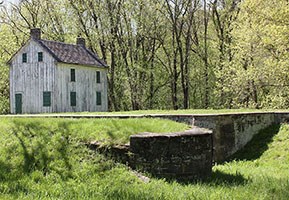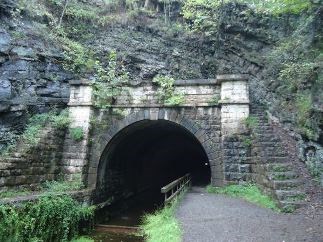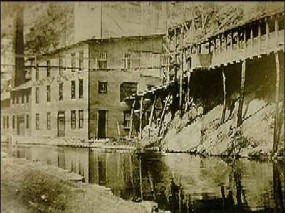
Visitors to the C&O Canal NHP today can see many structures which were integral to the operation of the canal, including locks, lockhouses, aqueducts, bridges, culverts, feeder dams, and waste weirs. Even the canal is a historic structure - the canal itself is called the "prism," because the surface of the canal bed is wider than the bottom, making it prism-shaped. The prism was lined with clay to keep the water sealed inside. Many of the structures which now remain are made of stone. The stonemasons were the most prominent craftsmen of the canal, painstakingly cutting blocks of stone to as small a tolerance as a half-inch. Today, the highway bridges that vault the river and the canal are formed of concrete, but this sort of construction did not develop until well after the canal was built. Concrete was not used on the canal until 1906, and is most commonly found as replacement work in waste weirs and lock pockets. 
NPS Photo One of the most iconic C&O Canal structures is a lift lock, often called simply a lock. The 74 locks along the canal raised or lowered boats. Learn more about how a lock works. Only one tunnel was built on the canal, but that tunnel is a masterpiece of engineering. The Paw Paw Tunnel (mile 155) is 3118 feet long and constructed with over six million bricks! 
NPS Photo The Round Top Cement CompanyThe Round Top Cement Company was located at mile 127.4 of the canal. As land was being surveyed for the canal, investigators found a large outcrop of limestone along the river, on the downslope of a hill called Round Top. A Mr. Shafer immediately built a plant to turn the limestone into cement on what would become the berm side of the canal. A berm is generally a bank of earth; in this case, it is the side of the canal where the towpath does not run. The river provided water power until the canal was built, and then the plant used water from the canal. As of 1882, the plant employed 100 workers, and it could produce up to 2200 barrels of cement per week. |
Last updated: December 9, 2025
